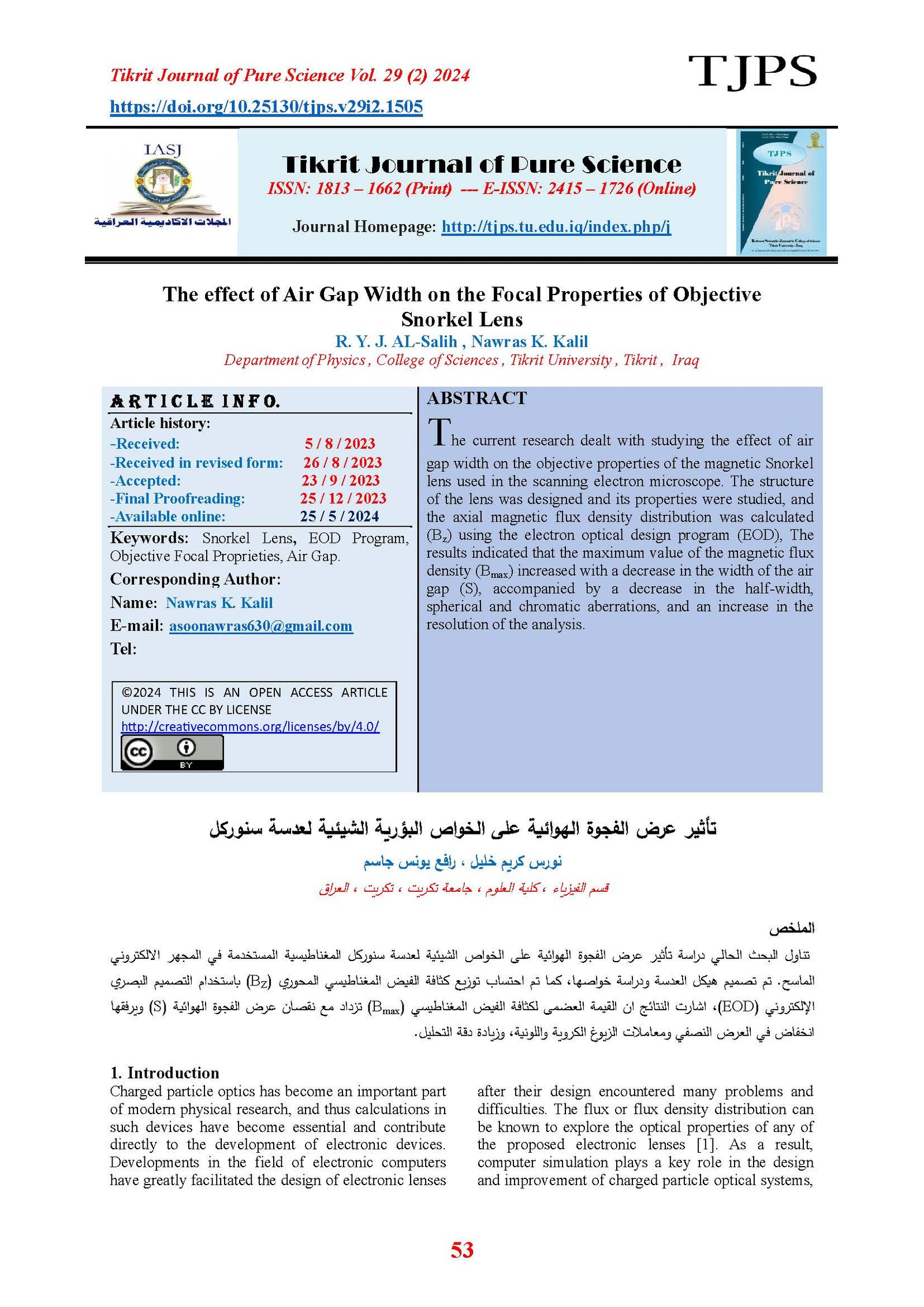The effect of Air Gap Width on the Focal Properties of Objective Snorkel Lens
Main Article Content
Abstract
The current research dealt with studying the effect of air gap width on the objective properties of the magnetic Snorkel lens used in the scanning electron microscope. The structure of the lens was designed and its properties were studied, and the axial magnetic flux density distribution was calculated (Bz) using the electron optical design program (EOD), The results indicated that the maximum value of the magnetic flux density (Bmax) increased with a decrease in the width of the air gap (S), accompanied by a decrease in the half-width, spherical and chromatic aberrations, and an increase in the resolution of the analysis.
Article Details

This work is licensed under a Creative Commons Attribution 4.0 International License.
Tikrit Journal of Pure Science is licensed under the Creative Commons Attribution 4.0 International License, which allows users to copy, create extracts, abstracts, and new works from the article, alter and revise the article, and make commercial use of the article (including reuse and/or resale of the article by commercial entities), provided the user gives appropriate credit (with a link to the formal publication through the relevant DOI), provides a link to the license, indicates if changes were made, and the licensor is not represented as endorsing the use made of the work. The authors hold the copyright for their published work on the Tikrit J. Pure Sci. website, while Tikrit J. Pure Sci. is responsible for appreciate citation of their work, which is released under CC-BY-4.0, enabling the unrestricted use, distribution, and reproduction of an article in any medium, provided that the original work is properly cited.
References
[1] Lencová, B. (1995). Computation of electrostatic lenses and multipoles by the first order finite element method. Nuclear Instruments and Methods in Physics Research Section A: Accelerators, Spectrometers, Detectors and Associated Equipment, 363(1-2):190-197. [2] Munro, E. (2011). Munro’s Electron Beam Software MEBS. Report, MEBS Ltd., London SW74AN, England. [3] Plies, E. (2000). Modren Electron Optics in SEM and Inspection. In Proceedings of the 12th European Congress on Electron Microscopy, 3:1423-1425. [4] Plies, E. (2018). Electron optics of low-voltage electron beam testing and inspection. Part I: Simulation tools. In Advances in Imaging and Electron Physics, 205:139-267. Elsevier. [5] Szilagyi, M. (2012). Electron and ion optics. Springer Science & Business Media.
[6] Mulvey, T. (1973). New electron-optical systems for SEM and STEM. In Inst. Phys. Conf. Ser., 18:16-21. [7] EL-Shahat, S.S., Hassan, G.S., & Al Amir, A.S.A. (2014). The effect of the lens size on performance of the single pole magnetic lens. Journal of Scientific Research in Physical & Mathematical Science, 1(5):9-21 [8] Al-Khashab, M.A., & Al-Shamma, M.T. (2019). Improvement of the Optical Performance of the Geometrical Parameters of Snorkel Magnetic Lens. Rafidain journal of science, 28(1): 85-97. [9] Abd Alghane, B.F., & Ahmad, A.K. (2021). Design of symmetric magnetic lenses with optimum operational conditions. Al-Nahrain Journal of Science, 24(1):30-38. [10] AL-Janan, M.K., & AL-Salih, R.Y.J. (2022). Design and studying the effect of Polepiece shape on the magnetic and optical properties of the unipolar lens. Tikrit Journal of Pure Science, 27(6):63-69. [11] Goldstein, J.I., Newbury, D.E., Michael, J.R., Ritchie, N.W., Scott, J.H.J., & Joy, D.C. (2017). Scanning electron microscopy and X-ray microanalysis. springer.
[12] Grivet, P. (1972). “Electron Optics”. 2nd ed. (Pergamon Press).
[13] El-Kareh, A.B. and El-Kareh, J.C.J. (1970), "Electron Beams Lenses and Optics", Academic Press: New York and London, vol.1 and 2.
[14] Tsimring, S.E. (2007), “Electron Beams and Microwave Vacuum Electronic”, Wiley: Canada. [15] Nakagawa, S., Miyokaum, T., & Noguchi, Y. (1980). Axial magnetic corrected field lens (CF lens)-principle and characteristics, minimizing Cs and Cc. Electron Microscopy, 1(3):901-909.
[16] Hawkes, P.W. (1972). Electron Optics and Electron Microscopy, Taylor and Francis Ltd., London, Ch., (2):27-44.
[17] Hawkes, P.W. and Kasper, E. (1996), “Principle of Electron Optics”, Academic Press, Inc., Ch. (24), 1: 350-365. [18] Lencová, B., & Zlámal, J. (2008). A new program for the design of electron microscopes. Physics Procedia, 1(1):315-324.
